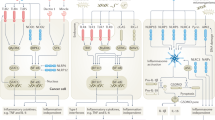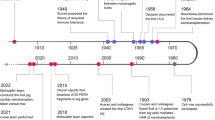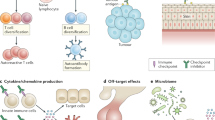Abstract
Pattern recognition receptors (PRRs) such as Toll-like receptors (TLRs) play key roles in initiating innate and adaptive immune responses. Based mainly on animal studies there is growing evidence to suggest that TLRs are involved in the development of chemotherapy-induced mucositis and in the propagation of graft versus host reactions as well as graft versus tumor effects in allogeneic hematopoietic stem cell transplantation (HSCT). In this review we discuss these findings along with the emerging, although still preliminary, clinical evidence, that points to a role of PRRs in determining the outcome of HSCT and new therapeutic perspectives that may be related to this development.
This is a preview of subscription content, access via your institution
Access options
Subscribe to this journal
Receive 12 print issues and online access
$259.00 per year
only $21.58 per issue
Buy this article
- Purchase on Springer Link
- Instant access to full article PDF
Prices may be subject to local taxes which are calculated during checkout

Similar content being viewed by others
References
Patra MC, Choi S . Recent progress in the development of Toll-like receptor (TLR) antagonists. Expert Opin Ther Pat 2016; 26: 719–730.
Kawai T, Akira S . The role of pattern-recognition receptors in innate immunity: update on Toll-like receptors. Nat Immunol 2010; 11: 373–384.
Iwasaki A, Medzhitov R . Control of adaptive immunity by the innate immune system. Nat Immunol 2015; 16: 343–353.
Vanhoecke B, Stringer A . Host-microbe cross talk in cancer therapy. Curr Opin Support Palliat Care 2015; 9: 174–181.
Villa A, Sonis ST . Mucositis: pathobiology and management. Curr Opin Oncol 2015; 27: 159–164.
Duncan M, Grant G . Oral and intestinal mucositis – causes and possible treatments. Aliment Pharmacol Ther 2003; 18: 853–874.
Trecarichi EM, Tumbarello M . Antimicrobial-resistant gram-negative bacteria in febrile neutropenic patients with cancer: current epidemiology and clinical impact. Curr Opin Infect Dis 2014; 27: 200–210.
See I, Iwamoto M, Allen-Bridson K, Horan T, Magill SS, Thompson ND . Mucosal barrier injury laboratory-confirmed bloodstream infection: results from a field test of a new National Healthcare Safety Network definition. Infect Control Hosp Epidemiol 2013; 34: 769–776.
Cutler C, Kim HT, Hochberg E, Ho V, Alyea E, Lee SJ et al. Sirolimus and tacrolimus without methotrexate as graft-versus-host disease prophylaxis after matched related donor peripheral blood stem cell transplantation. Biol Blood Marrow Transplant 2004; 10: 328–336.
Franchi L, Munoz-Planillo R, Nunez G . Sensing and reacting to microbes through the inflammasomes. Nat Immunol 2012; 13: 325–332.
Yang H, Tracey KJ . Targeting HMGB1 in inflammation. Biochim Biophys Acta 2010; 1799: 149–156.
Kornblit B, Masmas T, Petersen SL, Madsen HO, Heilmann C, Schejbel L et al. Association of HMGB1 polymorphisms with outcome after allogeneic hematopoietic cell transplantation. Biol Blood Marrow Transplant 2010; 16: 239–252.
Sonis ST . Pathobiology of mucositis. Semin Oncol Nurs 2004; 20: 11–15.
Holler E, Butzhammer P, Schmid K, Hundsrucker C, Koestler J, Peter K et al. Metagenomic analysis of the stool microbiome in patients receiving allogeneic stem cell transplantation: loss of diversity is associated with use of systemic antibiotics and more pronounced in gastrointestinal graft-versus-host disease. Biol Blood Marrow Transplant 2014; 20: 640–645.
Stringer AM, Al-Dasooqi N, Bowen JM, Tan TH, Radzuan M, Logan RM et al. Biomarkers of chemotherapy-induced diarrhoea: a clinical study of intestinal microbiome alterations, inflammation and circulating matrix metalloproteinases. Support. Care Cancer 2013; 21: 1843–1852.
Montassier E, Gastinne T, Vangay P, Al-Ghalith GA, Bruley d V, Massart S et al. Chemotherapy-driven dysbiosis in the intestinal microbiome. Aliment Pharmacol Ther 2015; 42: 515–528.
Touchefeu Y, Montassier E, Nieman K, Gastinne T, Potel G, Bruley d V et al. Systematic review: the role of the gut microbiota in chemotherapy- or radiation-induced gastrointestinal mucositis-current evidence and potential clinical applications. Aliment Pharmacol Ther 2014; 40: 409–421.
Montassier E, Batard E, Massart S, Gastinne T, Carton T, Caillon J et al. 16 S rRNA gene pyrosequencing reveals shift in patient faecal microbiota during high-dose chemotherapy as conditioning regimen for bone marrow transplantation. Microb Ecol 2014; 67: 690–699.
van Vliet MJ, Harmsen HJ, de Bont ES, Tissing WJ . The role of intestinal microbiota in the development and severity of chemotherapy-induced mucositis. PLOS Pathog 2010; 6: e1000879.
Birchenough GM, Nystrom EE, Johansson ME, Hansson GC . A sentinel goblet cell guards the colonic crypt by triggering Nlrp6-dependent Muc2 secretion. Science 2016; 352: 1535–1542.
Engels-Deutsch M, Pini A, Yamashita Y, Shibata Y, Haikel Y, Scholler-Guinard M et al. Insertional inactivation of pac and rmlB genes reduces the release of tumor necrosis factor alpha, interleukin-6, and interleukin-8 induced by Streptococcus mutans in monocytic, dental pulp, and periodontal ligament cells. Infect Immun 2003; 71: 5169–5177.
Alikhani M, Alikhani Z, He H, Liu R, Popek BI, Graves DT . Lipopolysaccharides indirectly stimulate apoptosis and global induction of apoptotic genes in fibroblasts. J Biol Chem 2003; 278: 52901–52908.
Akira S, Uematsu S, Takeuchi O . Pathogen recognition and innate immunity. Cell 2006; 124: 783–801.
Neyen C, Lemaitre B . Sensing Gram-negative bacteria: a phylogenetic perspective. Curr Opin Immunol 2016; 38: 8–17.
Uematsu S, Fujimoto K, Jang MH, Yang BG, Jung YJ, Nishiyama M et al. Regulation of humoral and cellular gut immunity by lamina propria dendritic cells expressing Toll-like receptor 5. Nat Immunol 2008; 9: 769–776.
Pontoppidan PL, Jordan K, Carlsen AL, Uhlving HH, Kielsen K, Christensen M et al. Associations between gastrointestinal toxicity, micro RNA and cytokine production in patients undergoing myeloablative allogeneic stem cell transplantation. Int Immunopharmacol 2015; 25: 180–188.
Jordan KK, Christensen IJ, Heilmann C, Sengelov H, Muller KG . Pretransplant C-reactive protein as A prognostic marker in allogeneic stem cell transplantation. Scand J Immunol 2014; 79: 206–213.
McNeer JL, Kletzel M, Rademaker A, Alford K, O'Day K, Schaefer C et al. Early elevation of C-reactive protein correlates with severe infection and nonrelapse mortality in children undergoing allogeneic stem cell transplantation. Biol Blood Marrow Transplant 2010; 16: 350–357.
Frank M, Hennenberg EM, Eyking A, Runzi M, Gerken G, Scott P et al. TLR signaling modulates side effects of anticancer therapy in the small intestine. J Immunol 2015; 194: 1983–1995.
Kaczmarek A, Brinkman BM, Heyndrickx L, Vandenabeele P, Krysko DV . Severity of doxorubicin-induced small intestinal mucositis is regulated by the TLR-2 and TLR-9 pathways. J Pathol 2012; 226: 598–608.
Ferrara JL, Levine JE, Reddy P, Holler E . Graft-versus-host disease. Lancet 2009; 373: 1550–1561.
van Bekkum DW, Roodenburg J, Heidt PJ, van der Waaij D . Mitigation of secondary disease of allogeneic mouse radiation chimeras by modification of the intestinal microflora. J Natl Cancer Inst 1974; 52: 401–404.
Beelen DW, Haralambie E, Brandt H, Linzenmeier G, Muller KD, Quabeck K et al. Evidence that sustained growth suppression of intestinal anaerobic bacteria reduces the risk of acute graft-versus-host disease after sibling marrow transplantation. Blood 1992; 80: 2668–2676.
Vossen JM, Heidt PJ, van den Berg H, Gerritsen EJ, Hermans J, Dooren LJ . Prevention of infection and graft-versus-host disease by suppression of intestinal microflora in children treated with allogeneic bone marrow transplantation. Eur J Clin Microbiol Infect Dis 1990; 9: 14–23.
Passweg JR, Rowlings PA, Atkinson KA, Barrett AJ, Gale RP, Gratwohl A et al. Influence of protective isolation on outcome of allogeneic bone marrow transplantation for leukemia. Bone Marrow Transplant 1998; 21: 1231–1238.
Jenq RR, Ubeda C, Taur Y, Menezes CC, Khanin R, Dudakov JA et al. Regulation of intestinal inflammation by microbiota following allogeneic bone marrow transplantation. J Exp Med 2012; 209: 903–911.
Jenq RR, Taur Y, Devlin SM, Ponce DM, Goldberg JD, Ahr KF et al. Intestinal Blautia Is Associated with Reduced Death from Graft-versus-Host Disease. Biol Blood Marrow Transplant 2015; 21: 1373–1383.
Shono Y, Docampo MD, Peled JU, Perobelli SM, Velardi E, Tsai JJ et al. Increased GVHD-related mortality with broad-spectrum antibiotic use after allogeneic hematopoietic stem cell transplantation in human patients and mice. Sci Transl Med 2016; 8: 339ra71.
Mathewson ND, Jenq R, Mathew AV, Koenigsknecht M, Hanash A, Toubai T et al. Gut microbiome-derived metabolites modulate intestinal epithelial cell damage and mitigate graft-versus-host disease. Nat Immunol 2016; 17: 505–513.
Heidegger S, van den Brink MR, Haas T, Poeck H . The role of pattern-recognition receptors in graft-versus-host disease and graft-versus-leukemia after allogeneic stem cell transplantation. Front Immunol 2014; 5: 337.
Gong XD, Ma LM, Zhu L, Guo HM, Ren LS, Ren RR et al. Prophylactic effect of TLR5 agonist flagellin on acute graft versus host disease after allogeneic hematopoietic stem cell transplantation and its mechanism. Zhongguo Shi Yan Xue Ye Xue Za Zhi 2012; 20: 965–970.
Sawitzki B, Brunstein C, Meisel C, Schumann J, Vogt K, Appelt C et al. Prevention of graft-versus-host disease by adoptive T regulatory therapy is associated with active repression of peripheral blood Toll-like receptor 5 mRNA expression. Biol Blood Marrow Transplant 2014; 20: 173–182.
Hossain MS, Jaye DL, Pollack BP, Farris AB, Tselanyane ML, David E et al. Flagellin, a TLR5 agonist, reduces graft-versus-host disease in allogeneic hematopoietic stem cell transplantation recipients while enhancing antiviral immunity. J Immunol 2011; 187: 5130–5140.
Skert C, Fogli M, Perucca S, Garrafa E, Fiorentini S, Fili C et al. Profile of toll-like receptors on peripheral blood cells in relation to acute graft-versus-host disease after allogeneic stem cell transplantation. Biol Blood Marrow Transplant 2013; 19: 227–234.
Ley RE, Backhed F, Turnbaugh P, Lozupone CA, Knight RD, Gordon JI . Obesity alters gut microbial ecology. Proc Natl Acad Sci USA 2005; 102: 11070–11075.
Lim JY, Ryu DB, Lee SE, Park G, Choi EY, Min CK . Differential effect of MyD88 signal in donor T cells on graft-versus-leukemia effect and graft-versus-host disease after experimental allogeneic stem cell transplantation. Mol Cells 2015; 38: 966–974.
Lin Y, Zhang L, Cai AX, Lee M, Zhang W, Neuberg D et al. Effective posttransplant antitumor immunity is associated with TLR-stimulating nucleic acid-immunoglobulin complexes in humans. J Clin Invest 2011; 121: 1574–1584.
Blazar BR, Krieg AM, Taylor PA . Synthetic unmethylated cytosine-phosphate-guanosine oligodeoxynucleotides are potent stimulators of antileukemia responses in naive and bone marrow transplant recipients. Blood 2001; 98: 1217–1225.
Ding X, Bian G, Leigh ND, Qiu J, McCarthy PL, Liu H et al. A TLR5 agonist enhances CD8(+) T cell-mediated graft-versus-tumor effect without exacerbating graft-versus-host disease. J Immunol 2012; 189: 4719–4727.
Seif AE, Barrett DM, Milone M, Brown VI, Grupp SA, Reid GS . Long-term protection from syngeneic acute lymphoblastic leukemia by CpG ODN-mediated stimulation of innate and adaptive immune responses. Blood 2009; 114: 2459–2466.
Charrier E, Cordeiro P, Brito RM, Harnois M, Mezziani S, Herblot S et al. Impaired interferon-alpha production by plasmacytoid dendritic cells after cord blood transplantation in children: implication for post-transplantation toll-like receptor ligand-based immunotherapy. Biol. Blood Marrow Transplant 2014; 20: 1501–1507.
Lorenz E, Schwartz DA, Martin PJ, Gooley T, Lin MT, Chien JW et al. Association of TLR4 mutations and the risk for acute GVHD after HLA-matched-sibling hematopoietic stem cell transplantation. Biol Blood Marrow Transplant 2001; 7: 384–387.
Elmaagacli AH, Koldehoff M, Hindahl H, Steckel NK, Trenschel R, Peceny R et al. Mutations in innate immune system NOD2/CARD 15 and TLR-4 (Thr399Ile) genes influence the risk for severe acute graft-versus-host disease in patients who underwent an allogeneic transplantation. Transplantation 2006; 81: 247–254.
Mensah NY, Peterlongo P, Steinherz P, Pamer EG, Satagopan J, Papanicolaou GA . Toll-like receptor 4 polymorphisms and risk of gram-negative bacteremia after allogeneic stem cell transplantation. A prospective pilot study. Biol Blood Marrow Transplant 2009; 15: 1130–1133.
Kornblit B, Enevold C, Wang T, Spellman S, Haagenson M, Lee SJ et al. Toll-like receptor polymorphisms in allogeneic hematopoietic cell transplantation. Biol Blood Marrow Transplant 2015; 21: 259–265.
Bochud PY, Chien JW, Marr KA, Leisenring WM, Upton A, Janer M et al. Toll-like receptor 4 polymorphisms and aspergillosis in stem-cell transplantation. N Engl J Med 2008; 359: 1766–1777.
Koldehoff M, Beelen DW, Elmaagacli AH . Increased susceptibility for aspergillosis and post-transplant immune deficiency in patients with gene variants of TLR4 after stem cell transplantation. Transpl Infect Dis 2013; 15: 533–539.
de Boer MG, Jolink H, Halkes CJ, van der Heiden PL, Kremer D, Falkenburg JH et al. Influence of polymorphisms in innate immunity genes on susceptibility to invasive aspergillosis after stem cell transplantation. PLOS ONE 2011; 6: e18403.
Camargo JF, Bhimji A, Kumar D, Kaul R, Pavan R, Schuh A et al. Impaired T cell responsiveness to interleukin-6 in hematological patients with invasive aspergillosis. PLoS ONE 2015; 10: e0123171.
Gruhn B, Kloppner N, Pfaffendorf-Regler N, Beck J, Zintl F, Bartholoma S et al. Toll-like 4 receptor variant, Asp299Gly, and reduced risk of hemorrhagic cystitis after hematopoietic stem cell transplantation. Biol Blood Marrow Transplant 2012; 18: 958–963.
Elmaagacli AH, Koldehoff M, Beelen DW . Improved outcome of hematopoietic SCT in patients with homozygous gene variant of Toll-like receptor 9. Bone Marrow Transplant 2009; 44: 295–302.
Elmaagacli AH, Steckel N, Ditschkowski M, Hegerfeldt Y, Ottinger H, Trenschel R et al. Toll-like receptor 9, NOD2 and IL23R gene polymorphisms influenced outcome in AML patients transplanted from HLA-identical sibling donors. Bone Marrow Transplant 2011; 46: 702–708.
Min YW, Rhee PL . The role of microbiota on the gut immunology. Clin Ther 2015; 37: 968–975.
Taur Y, Jenq RR, Perales MA, Littmann ER, Morjaria S, Ling L et al. The effects of intestinal tract bacterial diversity on mortality following allogeneic hematopoietic stem cell transplantation. Blood 2014; 124: 1174–1182.
Valentini M, Piermattei A, Di SG, Migliara G, Delogu G, Ria F . Immunomodulation by gut microbiota: role of Toll-like receptor expressed by T cells. J Immunol Res 2014, 586939.
Kesh S, Mensah NY, Peterlongo P, Jaffe D, Hsu K, Van Den BM et al. TLR1 and TLR6 polymorphisms are associated with susceptibility to invasive aspergillosis after allogeneic stem cell transplantation. Ann N Y Acad Sci 2005; 1062: 95–103.
Carvalho A, Cunha C, Carotti A, Aloisi T, Guarrera O, Di IM et al. Polymorphisms in Toll-like receptor genes and susceptibility to infections in allogeneic stem cell transplantation. Exp Hematol 2009; 37: 1022–1029.
Grube M, Brenmoehl J, Rogler G, Hahn J, Herr W, Holler E . Donor nucleotide-binding oligomerization-containing protein 2 (NOD2) single nucleotide polymorphism 13 is associated with septic shock after allogeneic stem cell transplantation. Biol Blood Marrow Transplant 2015; 21: 1399–1404.
Sivula J, Cordova ZM, Tuimala J, Jaatinen T, Partanen J, Volin L et al. Toll-like receptor gene polymorphisms confer susceptibility to graft-versus-host disease in allogenic hematopoietic stem cell transplantation. Scand J Immunol 2012; 76: 336–341.
Xiao HW, Luo Y, Lai XY, Shi JM, Tan YM, He JS et al. Donor TLR9 gene tagSNPs influence susceptibility to aGVHD and CMV reactivation in the allo-HSCT setting without polymorphisms in the TLR4 and NOD2 genes. Bone Marrow Transplant 2014; 49: 241–247.
Acknowledgements
KM is supported by the The Danish Childhood Cancer Foundation and The Danish Cancer Society.
Author information
Authors and Affiliations
Corresponding author
Ethics declarations
Competing interests
The authors declare no conflict of interest.
Rights and permissions
About this article
Cite this article
Kornblit, B., Müller, K. Sensing danger: toll-like receptors and outcome in allogeneic hematopoietic stem cell transplantation. Bone Marrow Transplant 52, 499–505 (2017). https://doi.org/10.1038/bmt.2016.263
Received:
Revised:
Accepted:
Published:
Issue Date:
DOI: https://doi.org/10.1038/bmt.2016.263
This article is cited by
-
Targeting Toll-Like Receptors for Cancer Therapy
Targeted Oncology (2018)



